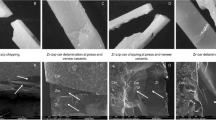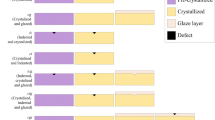Abstract
The porcelain fracture caused by low metal-ceramic bond strength is a critical issue in porcelain fused to metal(PFM) restorations. Surface roughening methods, such as sand blasting, acid etching and alkaline degreasing for the metal matrix are used to increase bond strength. However, the metal matrix of PFM processed by selective laser melting(SLM) has natural rough surface. To explore the effect of the original roughness on metal-ceramic bond strength, two groups of specimen are fabricated by SLM. One group of specimen surface is polished smooth while another group remains the original rough surface. The dental porcelain is fused to the specimens’ surfaces according to the ISO 9693:1999 standard. To gain the bond strength, a three-point bending test is carried out and X ray energy spectrum analysis(EDS), scanning electron microscope(SEM) are used to show fracture mode. The results show that the mean bond strength is 116.5 ± 16 MPa of the group with rough surface(R a=17.2), and the fracture mode is cohesive. However, when the surface is smooth (R a=3.8), the mean bond strength is 74.5 MPa ± 5 MPa and the fracture mode is mixed. The original surface with prominent structures formed by the partly melted powder particles, not only increases surface roughness but also significantly improves the bond strength by forming strong mechanical lock effect. Statistical analysis (Student’s t-test) demonstrates a significant difference (p<0.05) of the mean value of bond strength between the two groups. The experiments indicate the natural rough surface can enhance the metal-ceramic bond strength to over four times the minimum value (25 MPa) of the ISO 9693:1999 standard. It is found that the natural rough surface of SLM-made PFM can eliminate the porcelain collapse defect produced by traditional casting method in PFM restorations.
Similar content being viewed by others
References
ANUSAVICE K J. Phillips’ science of dental materials[M]. 11th ed. Philadelphia: W.B. Saunders, 2003.
ZHANG Lijun. Evaluation of bond characteristics between porcelain and titanium fabricated by laser rapid forming[D]. Xi’an: Fourth Military Medical University, 2009. (in Chinese)
TAKAHASHI J, ZHANG J Z, OKSZAKI M. Cast ability and surface hardness of titanium cast plates obtained from experimental phosphate-bonded silica molds[J]. Dental Materials Journal, 1994, 12(2): 238–244.
UENO S. Studies on the application of sintered titanium alloys for metal-ceramic restorations[J]. Dental Materials Journal, 1992, 11(4): 44–56.
VENCE B S. Electroforming technology for galvano-ceramic restorations[J]. Journal of Prosthodontics, 1997, 77(4): 444–449.
SAMET N, RESHEFF B, GELBARD S, et al. A CAD/CAM system for the production of metal coping for porcelain-fused-to-metal restoration[J]. Journal of Prosthetic Dentistry, 1995, 73(5): 457–463.
ALKHIARY Y M, MORGANO S M, GIORDANO R A. Effects of acid hydrolysis and mechanical polishing on surface residual stresses of low fusing dental ceramics[J]. Journal of Prosthetic Dentistry, 2003, 90(2): 133–142.
LIBBY G, ARCURI M R, LAVELLE W E, et al. Longevity of fixed partial dentures[J]. Journal of Prosthetic Dentistry, 1997, 7(82): 127–131.
Product information: PM100 Dental, Phenix TM Systems[EB/OL]. [2013-07-01]. http://www.phenix-systems.com.
VAN BAEL S, KERCKHOFS G, MOESEN M, et al. Micro-CT based improvement of geometrical and mechanical controllability of selective laser melted Ti6Al4V porous structures[J]. Materials Science and Engineering A, 2011, 528(24): 7 423–7 431.
YAN Zhangong, LIN Feng, QIN Haibo, et al. Overview of direct metal rapid prototyping and manufacturing technologies[J]. Chinese Journal of Mechanical Engineering, 2005, 41(11): 1–7.
LIU Zhengdao, ZHANG Xiancheng, XUAN Fuzhen, et al. Effect of laser power on the microstructure and mechanical properties of TiN/Ti3Al composite coatings on Ti6Al4V[J]. Chinese Journal of Mechanical Engineering, 2013, 26(4): 1–8.
SHANG Xiaofeng, LIU Weijun, WANG Tianran. Scanning mode of the metal powder laser shaping[J]. Chinese Journal of Mechanical Engineering, 2005, 41(7): 99–102.
XIN Xianzhen, XIANG Nan, CHEN Jie, et al. Corrosion characteristics of a selective laser melted Co-Cr dental alloy under physiological conditions[J]. Journal of Materials Science, 2012, 47(12): 4 813–4 820.
SHANG Xiaofeng, LIU Weijun, WANG Wei, et al. Slope limit of part made in metal powder laser shaping[J]. Chinese Journal of Mechanical Engineering, 2007, 3(8): 97–100.
BENNETT R C, SUTCLIFFE C H. Selective laser melting in applications and developments using MCP Realizer SLM[J]. Proceedings of the Fourth Laser Assisted Net Shape Engineering, 2004: 541–545.
COULON N, AUBRY P, TEULET P. New trends in laser sintering: analysis of the process and new applications[J]. Proceedings of the Laser Materials Processing Conference, 2005: 286–295.
XIANG Nan, XIN Xianzhen, CHEN J, et al. Metal-ceramic bond strength of Co-Cr alloy fabricated by selective laser melting[J]. Journal of Dentistry, 2012, 40(6): 453–457.
JEVREMOVIC D, PUSKAR T, KOSEC B, et al. The analysis of the mechanical properties of F75 Co-Cr alloy for use in selective laser melting(SLM) manufacturing of removable partial dentures(RPD) [J]. Metalurgija, 2012, 51(2): 171–174.
JEVREMOVIC D, KOJIC V, BOGDANOVIC G, et al. A selective laser melted Co-Cr alloy used for the rapid manufacture of removable partial denture frameworks: Initial screening of biocompatibility[J]. Journal of the Serbian Chemical Society, 2011, 76(1): 43–52.
XIN X, XIANG N, CHEN J, et al. In vitro biocompatibility of Co-Cr alloy fabricated by selective laser melting or traditional casting techniques[J]. Materials Letters, 2012, 88: 101–103.
KIM B, ZHANG Y, PINES M. Fracture of porcelain-veneered structures in fatigue[J]. Journal of Dental Research, 2007, 86(2): 142–146.
REYES M J, OSHIDA Y, ANDRES C J, et al. Titanium porcelain system Part III: effects of surface modification on bond strengths[J]. Bio-Medical Materials and Engineering, 2001, 11(2): 117–136.
HAMMAD I A, YOUSEF F T. Designs of bond strength tests for metal-ceramic complexes: review of the literature[J]. The Journal of Prosthetic Dentistry, 1996, 75(6): 602–608.
MA Xixian. Prosthodontics[M]. 5th ed. Beijing: People’s Medical Publishing House, 2006. (in Chinese)
ZINELIS S, BARMPAGADAKI X, VERGOS V, et al. Bond strength and interfacial characterization of eight low fusing porcelains to cpTi[J]. Dental Materials Journal, 2010, 26(3): 264–273.
Author information
Authors and Affiliations
Corresponding author
Additional information
This project is supported by the Royal Academy of Engineering Research Exchanges with China and UK (Grant No. 2012-P02), and National Key Technology R&D Program of Ministry of Science and Technology of China (Grant No. 2012BAF08B03), and National Natural Science Foundation of China (Grant No. 51375189)
ZHANG Sheng, born in 1984, is currently a PhD candidate at Huazhong University of Science and Technology, China. His research interests include metal additive manufacturing.
LI Yong, born in 1973, is currently a dental technician at Stomatological Hospital, Wuhan University, China. His research interests include the application of CAD/CAM in prosthodontics.
HAO Liang, born in 1972, is currently a senior lecturer at University of Exeter, UK. His research interests include additive manufacturing and the functional materials.
XU Tian, born in 1989, is currently a graduate student at Huazhong University of Science and Technology, China. Her research interests include the process of additive manufacturing.
WEI Qingsong, born in 1975, is currently an associate professor at Huazhong University of Science and Technology, China. He received his PhD degree from in 2006. His research interests include additive manufacturing and near net shape forming.
SHI Yusheng, born in 1962, is currently a professor at Huazhong University of Science and Technology, China. His research interests include additive manufacturing and near net shape forming.
Rights and permissions
About this article
Cite this article
Zhang, S., Li, Y., Hao, L. et al. Metal-ceramic bond mechanism of the Co-Cr alloy denture with original rough surface produced by selective laser melting. Chin. J. Mech. Eng. 27, 69–78 (2014). https://doi.org/10.3901/CJME.2014.01.069
Received:
Revised:
Accepted:
Published:
Issue Date:
DOI: https://doi.org/10.3901/CJME.2014.01.069




